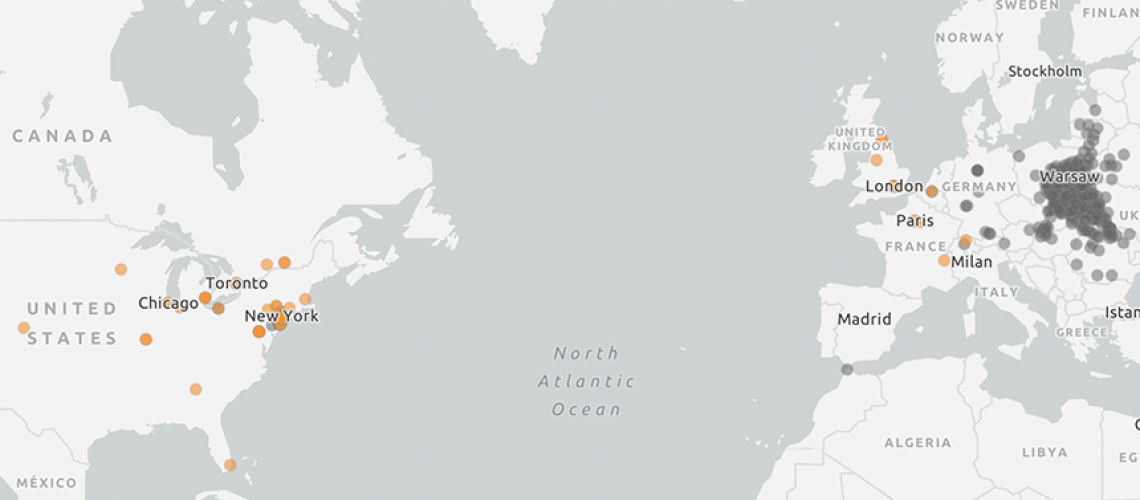There is a beautiful old map of Bais Yaakov schools, done in 1931. I misdated it in my book on Bais Yaakov, and someone named Robbert Baruch wrote to tell me that. It turned out he knew everything about the map, because he was planning to follow parts of it on his motorcycle the next summer. So I guess there are people in the world who love maps even more than I do.

One of the first things I thought about doing when Dainy Bernstein and I first launched the Bais Yaakov Project Website in 2019 was to map all the Bais Yaakovs in the world. How hard could that be, right? For reasons I’m happy to explain below, it turned out to be really hard—it’s taken about two straight years of work. I was giddy, really emotional, when the map was unveiled at the Bais Yaakov Conference last March. But it’s also been hard to let it go, to stop tweaking, given that it’s almost certainly unfinished. We’ve done what we can: the rest is up to you now: the legions of Bais Yaakov graduates all over the world, historians (amateur or academic) historians of Orthodoxy. This is the beginning of what we hope and expect will be a collective attempt to identify every Bais Yaakov that ever was, supplying basic details and, where available, photographs and website links.
Why map Bais Yaakov? Maps might seem mute and “neutral”, but they have things to say that might otherwise be missed. One thing the Bais Yaakov Project map contributes to previous estimates about the scope of the system in interwar Poland is the rather surprising insight that the various lists previously available significantly undercounted Bais Yaakovs in Poland. This is surprising because it would be easy to assume that the Central Office exaggerated the number of schools on grant applications or publicity brochures. What the numbers make clear is that schools called Bais Yaakov operated in Poland and elsewhere with no apparent communication with the Central Office.
Along with the mismatch between official lists and schools on the ground, mapping Bais Yaakov faced another challenge: What counts as a Bais Yaakov is not always clear. Bais Yaakov operated in many different contexts, under different names and spellings. Where are the boundaries between a “Bais Yaakov-type” school (whether or not called Bais Yaakov) and one that falls out of that category? Obviously, different choices than ours are possible; it could be argued, for instance, than schools run by Hasidic groups, whether or not they consider themselves part of Bais Yaakov, are descendants of Sarah Schenirer’s system. We took a more conservative approach, as you will see. But most importantly, we have tried to be as transparent as possible about our methods and categories: for those interested, the notes compiled by the mapmakers make their methodology crystal clear, and demonstrate the degree of professionalism they brought to their work.
These challenges should explain why the map took years of work. It also took some luck, the luck that Charna Perman, a truly extraordinary undergraduate research assistant, applied to the Project, and the good fortune that Dikla Yogev agreed to be Project Manager of the Bais Yaakov Project, supervising the mapping project with scholarly rigor.
The map is not only scholarly, it is also lovely and fascinating. If all you have is five minutes, click the “Timeline” tab and then press Play to watch the map grow over the years, one dot lighting up after the other the way the night sky unfolds. This is the world of Bais Yaakov, presented in visual form for the first time (as far as we know) since 1931. Bais Yaakov girls, past and present, pious and fallen, know the power of the story of what holds us together around the world. But to be able to see that world, to watch the dots light up in succession across the globe (or, more sadly, fall into history with the Holocaust), is to experience this history on a different but to me no less moving register.
Most importantly: This is a crowd-sourced project. We are well-aware that the findings are almost certainly incomplete, and that peripheral or short-lived Bais Yaakovs escaped detection. Of the ones we found, we would love to include more data—photos, anecdotes, comments. We suspect that there are
legions of Bais Yaakov graduates who share our curiosity about this phenomenon that has so shaped our lives, and who will appreciate it being made visible in this map.
Enjoy the map! And contact us with anything we missed! We always appreciate receiving your comments.
View the Interactive Map »

